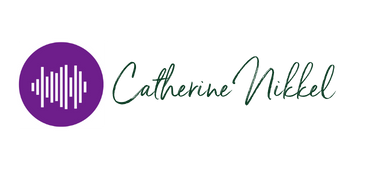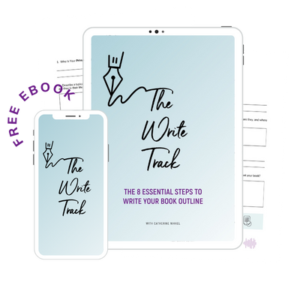Writing a book is an incredible experience, but I’m not going to sugarcoat the process and tell you that it’s easy or there is one way to do it. Spoiler: using a book outline should be a nonnegotiable in the process.
Becoming a successful author is about more than having a basic idea and putting pen to paper – if you do this, you risk experiencing writer’s block, writing a book that could be more cohesive, or worse… never finishing.
Before you write your book, you need to brainstorm, plan, and get all the ideas out of that brilliant head of yours so that when you do sit down to write, you have a solid structure and clear pathway towards getting your book completed.
Let me tell you if you’re like me and enjoy structure, clarity and organization …
Your best friend during your book writing process will be a book outline.
What is that, or how can you prepare one?
Not to worry, I’m going to break everything down for you! And as always, you are more than welcome to contact me with any questions I may have missed with this post.
What is a Book Outline?
A book outline is the road map for your book.
It includes all your key ideas organized in the exact way that you want your story to flow to the reader.
A book outline is so much more than a brain dump; it lists all of your chapters or sections and a few details about what you will include in each one.
This will evolve into a detailed outline, and you may even change a few details as you go; however, the outlining process will set you up for success as you write.
What are the Benefits of Creating a Book Outline?
A book outline is such an essential part of your book-writing journey.
Whether you are writing your first or fifth book, this is a must.
Creating a great book outline takes time, but if done well and intentionally, it helps you write faster and finish your book in record time.
Here are some of the key benefits of creating a book outline:
It helps you filter and organize your ideas.
An outline will help ensure that only relevant content makes it into your book.
As a writer, you probably have many ideas about what you want to include in your book, but the reality is that only some things will align with your book’s theme or resonate with your audience. So when you outline, you decide what stays in and what gets cut.
Don’t worry; you can save all those other great ideas for a future project or perhaps your second book 😉 I like to call the spot for these future ideas as the parking lot. I believe writing them down is important – if it pops in your head, write it down!
It keeps you on track.
An outline works like a checklist; I don’t know about you, but checking something off a list as I complete it feels so good!
This is a great way to track your progress and helps prevent writer’s block. Additionally, whether it’s fictional writing or nonfictional writing, a book outline can help you set realistic and manageable deadlines.
I know when I’m ghostwriting books for clients, this is something I feel they value as much as I do. See, with my book clients and my book coaching clients, we often collaborate on google docs — a live look at where we’re at and allows us to work seamlessly together. (Google Docs is a great way to store your outline since it’s accessible anywhere)
Creates a cohesive story
With an outline, you don’t have to worry about missing any critical details in your story or a sagging middle, and your book outline will ensure that you hit on all the key points you want to share with your readers.
Since not all books are written in chronological order, using a book outline template (free template or otherwise), it can help you just unload the thoughts onto the page where you can move them around with ease if needed.
It helps you write meaningful content.
Rather than worrying about what details should come next, you can focus on writing your story and capturing the ideas and emotions you want to convey to your reader.
It allows you to see the bigger picture.
Once you start writing, it’s easy to get lost in the tiny details of each chapter or section. Focusing on the big picture first ensures that you can give equal attention to all parts of your story, making for a more intriguing read from start to finish.
Think about this as your macro idea, your BIG goal or, your North Star. Each of those details or micro stories will serve a purpose providing these little stars lead to the north one.
Picture the details are your galaxy and, the bigger picture being that big, bright and beautiful North Star. Each star matters, whether they matter to this particular bigger picture concept, you will discover along the way.
How does a book outline differ between fiction and nonfiction?
An outline will serve you well regardless of your writing style and the type of book you want to write.
However, let’s be clear – depending on whether you want to write a nonfiction or fiction book, and you will require a very different outlining method.
When writing a nonfiction book, your book and outline will likely follow a theme, critical ideas, or learnings you want to share. Crafting your book may require research, speaking with experts, or leveraging your own real-life experience or the experiences of others. In addition, you will want to provide key takeaways and actionable items so people can read your story and learn from it.
While fiction writers, venturing into the nonfiction writing world, also require research and integrating your own experiences, a novel outline focuses on the story structure.
Therefore, it requires a few considerations that are quite different than a nonfiction book (e.g., the main character, character arcs, character development, novel outlines, the novel’s structure, plot structure and the arc of your story, the inciting incident, etc.)
Consider the difference between J.K. Rowling’s Harry Potter and James Clear’s Atomic Habits – these books are organized and written in very different ways because one builds excitement through the plot points, and the other is meant to share a personal story and provides practical advice you can use to better your life.
Although common traits like the story outline, plot outline, main characters and central theme will require the same attention — I’m sure you can appreciate the differences from imagination versus lived experiences.
I help nonfiction writers share their stories with the world, but there are many great coaches and resources available if you want to write a fictional book.
Building Your Vision
You may be convinced that writing an outline will suit your book, and I’m here silently cheering you on.
However, hold on to your hat because you still need to consider a few essential things before preparing your outline.
Before you can become a bestselling author, you need a vision.
You must be clear on what you are writing, why, and who your audience will be.
Take your time with this part because writing a book takes hard work, and you will want to ensure you are writing about something you are genuinely excited to share. Your story matters, and I want to see you give it the justice [and love] it deserves.
Here are some reflection questions you can use to build or refine your vision for your book:
What is Your Book Idea?
What do you want to write about? Is there a topic or theme that is to calling you?
Consider this the elevator pitch of your book – can you describe your main idea and takeaway in one sentence? This is a quick and easy way to summarize your ideas in a short and powerful way.
Why are you writing this book?
This will be personal to you.
Was there a significant event that changed the course of your life?
Do you have years of experience to share that you know would be valuable for others?
Do you want to supplement your business or course with a book that contains a cohesive set of stories, learnings, and actionable items?
Or, if you are writing fiction — what are you hoping to achieve with your book?
Who is your audience? How will your book impact them?
Think about who you envision picking up your book once it hits the bookshelves.
Who are they?
What is their life like?
What challenges are they experiencing that may draw them to this book?
How will reading your book transform their life?
These people will buy and read your book, which is why it’s so important that you understand what they need to hear.
Check out my customer persona worksheet if you need some support bringing your ideal reader to life.
Putting it all together
All of these aspects combine to create what I like to call your North Star – this is what will help you determine what to include (and not include) in your book and keep you focused on your audience and objectives.
I like to encourage my clients to combine their vision into a North Star statement:
I will use my book to target {introduce your primary audience} by teaching them {your purpose/book idea}, which will lead to my ultimate goal of more {insert objectives}
You can post this in your work space, save it as the background on your phone or repeat it to yourself like an affirmation every time you sit down to write.
It’s a powerful way to anchor yourself and stay on track with the writing process.
3 Nonfiction Book Outlining Methods
Now that you have a better sense of where you are going with your book, here are 3 Nonfiction Book Outlining Methods.
If this is your first time writing a book, don’t be discouraged if you start with the outline process and realize another is better suited for you – it’s all part of the learning process!
When I published my first book, the Lightbulb Moments Journal, I still worked with a book outline and I can’t imagine doing it any other way. On another personal note, I also fall into the whole mindset of can there really be a one size fits all when it comes to a book outline?
And I discovered although many book outline templates are great resources … with a background in social work, I wanted to create more of an individualized book outline for my clients. I’ve learned over my professional career(s) that, everyone isn’t a one size fits all — some of us require a little personalization, right?
It’s how I feel wholeheartedly.
This is when I developed my proprietary Framework I call VOICE.
Although on its own perhaps feels a little vague but hear me out;
V is for Vision (without it, you will fall into a lot of frustration and potential run into the inability to push through the writing process).
O is for (you guessed it) Outline (clearly I emphasize this to the max because, I know how much it can assist with the book writing process).
I is for Implement (in other words, time to take action and start writing).
C is for Cleanup (every single book needs this – I promise).
E is for Evaluate (because once you’ve finished writing … hate to be the bearer of bad news but, the work has just begun!).
This framework is part of both the outline process I use while moving into first, second and third drafts and, what to do with that beautifully written manuscript.
Method 1: Chapter-by-Chapter Outline
This is the method that I recommend to my clients, and there are so many different approaches you can take.
Essentially, this method consists of creating suggested titles for all of your chapters (these can change later) that reflect the essence of what you want to share and then listing one or two sentences that encompass crucial ideas that will be used to support this.
Don’t worry too much about how many chapters you have at the beginning, as this can change as you go whereas, the in depth part comes later
What you include in this outline template is up to you – you can start with something short and sweet and then turn it into a more detailed outline as you go.
Psst.. when I help my clients put together book outlines, I share some great outline templates that simplify the process! Additionally, I never number chapters (or create the table of contents until much later) I have client who assumed her last chapter would be the last chapter – surprise! We moved it to be chapter one and the book took on a new life for her and afterwards, her readers. Sometimes starting with the climax or ending are a good premise to consider.
Method 2: Mind Map
This is a fun way to brainstorm and use the ideas you generate to create your book outline.
A mind map starts with one word at the centre and branches out to include related ideas or thoughts. You likely worked through a process similar to this in elementary or middle school to learn about word association. (we used to call this cloud bubbles)
You can either create a mind map for your entire book or prepare them for individual chapters.
Method 3: Skeletal Outline/Timeline
This outline style is excellent for writing books that need to follow a chronological sequence or timeline of events.
You can start by listing out the flow of ideas you want to share or the timeline of events. From there, you can add details to each idea/point to build the outline for your book.
Remember that the first draft of your book outline does not have to be the final one.
You are the author and can re-arrange ideas or the flow of your story as you see fit.
This is one of the reasons that working with a book coach can be so valuable; it’s always nice to have an experienced second set of eyes on your outline.
Ready to share your big idea and join the list of successful authors?
The fact that you are here reading this post means you are committed to creating an unforgettable story for your readers – I can’t wait to see what you create.
Know that you don’t have to struggle through this journey alone.
After writing 14 books and getting my share of coaching, I have developed an easy-to-follow process to help you write your book outline and turn that into a first draft manuscript in 120 days!
Yes, it is possible!
And, I know it sounds absolutely crazy, overwhelming or unbelievable BUT, it’s absolutely true. I’ve had several clients amazed at how quickly they can execute their thoughts with the right book outline and, the right guidance.
Why shouldn’t you join the list of best selling authors? For what it’s worth, I believe YOU have an important story to share. A story that may even be the answer, clarity or inspiration someone is looking for.
Curious about what tools you might need to start your book outline?
The truth is, you don’t need much to start.
You may decide you would like to stick with pen to paper or, use a word processor like Microsoft Word or Google Docs. Or, buckle up for this one — voice recording is another option I like to suggest. Sometimes we can articulate our thoughts and emotions well on paper and other times the most logical way to get ’em out, is speaking about it.
Should you choose voice recording, there are many inexpensive ways to have these transcribed later.
The other tool I suggest is Grammarly. This is an excellent platform (both free and paid versions) that can help you with sentence structure, grammar, spelling, and cohesiveness overall. (note: this is ideal once you have surpassed the book outline and moving your new story into the draft stage)
Other than that you are good to go.
Lastly, I was included in an expert round up for non-fiction authors looking to get started.
Here are the top 4 Tips I shared in that piece;
Write every single day.
Creating a daily habit of writing is the best way to help foster your creativity, avoid writer’s block, and help develop your writing skills. It’s OK to be vulnerable. Your first draft won’t be your final manuscript, so get raw, real and authentic; the editing process can happen later.
Read often.
Reading other great ones is a no-brainer if you want to become a successful writer. It’s best to consume all types of writing, from fiction to nonfiction, biographies, short stories, etc.
Be willing to grow.
Every piece of content you create contributes to your growth, evolution, and realizations as an author. Where you started is not where you will finish (or shouldn’t!). With each piece of writing, be open to learning something new. It’s a journey and one well worth it. Being open to feedback is essential.
Have someone else proofread your work.
You might be starting, and it’s not in the budget yet to hire for this position—ask a friend, family member, or colleague to give things a once over. The second set of eyes is optimal on your journey to becoming a successful author.
You can read the full article here → Happy Reading!
Overall, I hope you have found this post valuable and I can’t wait to see what you create.
Intrigued? Book a coffee chat with me and discuss how I can help you get your book written.
Use your Voice, Make an Impact.
Catherine x

Email: catherine@catherinenikkel.com
Resources
What type of Content Creator are you? Take the Quiz! – 4 different types of creators, which one are you?
Need help telling your story in your own voice? Let’s make it happen. Schedule a consultation with me here






